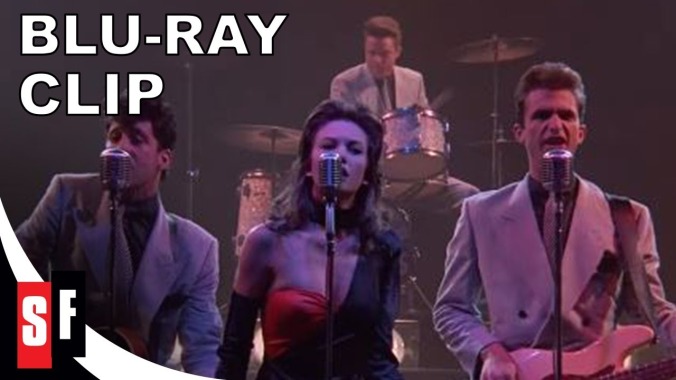For pure '80s-meets-'50s rock 'n' roll aesthetics, it's hard to top Streets Of Fire
Film Features Watch This
Watch This offers movie recommendations inspired by new releases or premieres, or occasionally our own inscrutable whims. This week: The recent (and very strange) Jeannette: The Childhood Of Joan Of Arc has us tapping our toes to other rock musicals, rock operas, and rock-driven movies.
Streets Of Fire (1984)
Even the MTV generation didn’t know what to do with Streets Of Fire. With its flimsy, Western-inspired plot and all the chemistry of a wet washcloth between romantic leads Diane Lane and Michael Paré, Walter Hill’s 1984 “rock ’n’ roll fable” bombed at the box office and flopped with critics (save for Roger Ebert, who gave the film one of its few positive reviews). Plans for a trilogy were scrapped by a humbled Universal, and the film soon faded from popular memory, where it’s ironically been eclipsed by a hit song from its soundtrack. But like many exercises in knowing kitsch, it’s only improved with age.
Perhaps the ne plus ultra of the ’80s-does-’50s aesthetic, Streets Of Fire takes such classic symbols of midcentury Americana as Studebakers, corner diners, and black leather motorcycle jackets and drenches them in New Wave neon, creating an alternate dimension—“another time, another place,” as an opening title card declares—that’s familiar, but still ineffably strange. It’s a world where ’80s punk coexists with ’60s soul and everyone talks in slang straight out of a ’50s B-movie, where the lone gunslinger wears a duster designed by Giorgio Armani and the baddest guy in town can be laid low by a well-placed sock in the jaw. There’s a certain innocence to the film, the dream of a 13-year-old boy who fell asleep at the drive-in as directed by one of American cinema’s boldest and most kinetic visual stylists.
The story, such as it is, revolves around Tom Cody (Paré), an ex-military man who returns to his rough-and-tumble hometown (actually a combination of downtown Chicago and a Universal backlot) and discovers that his ex-girlfriend Ellen Aim (Lane), now a hugely popular rock star, has been kidnapped by a greaser gang led by the dangerously alluring Raven (Willem Dafoe). Cody soon teams up with butch drifter McCoy (Amy Madigan) and Ellen’s dorky manager/boyfriend Billy Fish (Rick Moranis) to go rescue his girl—she says she’s with Billy Fish now, but we all know who she really loves—and the final showdown between good and evil has been set into motion. First stop: a raucous warehouse party full of leather boys gyrating to L.A. cowpunks The Blasters.
Hill tried—and failed—to get Bruce Springsteen to grant permission to re-record his song “Streets Of Fire” for the film’s concert finale, but his replacement was an even better fit: Jim Steinman, Meat Loaf’s favorite songwriter, who ended up writing the songs that bookend the film, “Nowhere Fast” and “Tonight Is What It Means To Be Young.” Steinman does the hot chrome and dizzy musk of restless adolescent energy better than anyone, with a ’50s throwback sensibility and a musical-theater flair that provide the perfect aural equivalent to Hill’s vision for the film.
The soundtrack in general is outstanding, and under-appreciated: Stevie Nicks wrote another original song, “Sorcerer,” for Lane’s fictional band Ellen Aim and The Attackers, as did Heartbreakers Tom Petty and Benmont Tench with “Never Be You.” (Session singers performed their numbers, as well as both of the Steinman tunes.) “Hound Dog” songwriters Jerry Leiber and Mike Stoller secured the soundtrack’s rockabilly cred by writing a song for The Blasters to perform on screen, The Fixx plays over the closing credits, and roots musician Ry Cooder contributed the score, which is either comically simplistic or charmingly so, depending on your point of view. But the soundtrack’s best-remembered song ended up being more popular than the movie: “I Can Dream About You,” a Top 10 hit for songwriter Dan Hartman in the summer of ’84 that’s performed by fictional R&B outfit The Sorels in the film. (You’ve definitely heard it, whether on soft-rock radio or at a karaoke night.)
Streets Of Fire is a mainstream example of what theorists refer to as “pure cinema,” a sublime marriage of sound and visuals that prioritizes visceral experience over such prosaic concerns as plot and character. While Paré is undeniably flat and Lane underutilized—particularly when compared to her role as a punk frontwoman in Ladies And Gentlemen, The Fabulous Stains—it’s in the bold lighting and dynamic camerawork from Hill’s longtime cinematographer Andrew Laszlo that the real appeal of Streets Of Fire becomes apparent. That’s particularly true of the musical sequences, filmed in wide shots that incorporate the audience dancing and singing along for an adrenaline rush similar to what you get at an actual live concert. Plus, Willem Dafoe menacingly emerges from a wall of flames while wearing black latex overalls. How’s that for pure aesthetics?
Availability: Previously only available on VHS, Streets Of Fire was released on a gorgeously restored Blu-ray by Shout! Factory last year. It’s also available as a digital rental, although it’s not clear if that comes from the same 2k restoration as the Blu-ray.